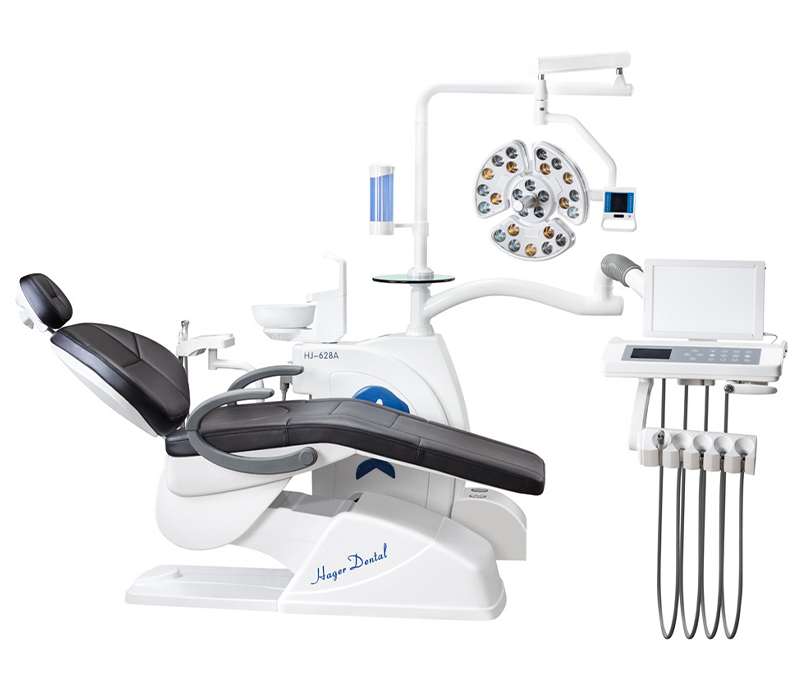Dental Chair Buyer's Guide: How to Choose the Right One for Your Clinic's Needs
In today's competitive dental landscape, selecting the right dental chair is no longer just about functionality; it's a crucial element in enhancing patient comfort, operational efficiency, and overall practice success. As a dental clinic owner or manager, navigating the vast array of options can be daunting. This guide is designed to walk you through the key considerations for choosing a dental chair that aligns with your clinic's unique needs, ensuring a seamless integration of technology, ergonomics, and aesthetics.
From the initial impression of a sleek, modern design to the advanced features that support both patient and dentist comfort, every aspect of the dental chair plays a vital role in shaping the patient experience. By focusing on factors such as chair type, configuration options, durability, price, and after-sales support, you can create an environment that not only meets but exceeds patient expectations.
Understanding Dental Chair Types
Dental chairs primarily come in two types: electric dental chairs and hydraulic dental chairs. Each type has its unique benefits and is suited to different clinical environments.

Electric Dental Chairs
- Key Features: Electric dental chairs use electric motors to control movements, offering precise adjustments for height, tilt, backrest, and armrest positions. They often come with programmable settings, allowing dentists to save specific positions for different procedures or patients. This feature enhances workflow efficiency and patient comfort by minimizing the time spent adjusting the chair during appointments.
- Benefits: These chairs provide finer control over positioning, which is particularly beneficial for complex procedures requiring precise access to the oral cavity. The memory function allows for quick adjustments, saving time during appointments and improving overall productivity.
- Considerations: Electric chairs are generally more expensive than hydraulic ones but offer advanced features like customizable settings and improved ergonomics. They are ideal for clinics that prioritize precision and efficiency.
Hydraulic Dental Chairs
- Key Features: Hydraulic dental chairs utilize a hydraulic system for smooth and accurate movement. They are controlled via foot pedals or touchpads, allowing real-time adjustments during treatments without interrupting procedures. This hands-free operation is beneficial for maintaining asepsis and reducing distractions during procedures.
- Benefits: Hydraulic chairs are known for their stability and quiet operation, providing a secure platform for dental procedures. They are often less expensive than electric chairs and require less maintenance, making them a cost-effective option for smaller clinics or those with limited budgets.
- Considerations: While hydraulic chairs offer basic adjustments, they may lack the precision and customization options of electric chairs. However, they are reliable and suitable for general dental practices.
Table: Comparison of Electric and Hydraulic Dental Chairs
| Feature | Electric Dental Chairs | Hydraulic Dental Chairs |
|---|---|---|
| Control System | Electric motors for precise adjustments | Hydraulic system for smooth movements |
| Customization | Programmable settings for specific procedures | Limited customization options |
| Cost | Generally more expensive | Less expensive |
| Maintenance | Requires regular software updates and motor checks | Less maintenance-intensive |
| Ergonomics | Often designed with advanced ergonomic features | Basic ergonomic design |
This table provides a quick comparison of the key features of electric and hydraulic dental chairs, helping you decide which type best suits your clinic's needs.
Configuration Options
When choosing a dental chair, consider the following configuration options:
- Control Panels: Look for chairs with intuitive control panels that allow easy adjustments of chair positions, lifting speed, and access to operatory accessories. A user-friendly interface can significantly enhance the dentist's workflow by reducing the time spent on adjustments.
- Suction Systems: Ensure the chair is compatible with your clinic's suction system, whether it's a dry, wet, liquid, or Venturi system. Compatibility is crucial for maintaining a clean and hygienic environment during procedures.
- Ergonomic Design: Opt for chairs with ergonomic features that support neutral posture for both dentists and patients, reducing strain and improving accessibility to the oral cavity. Ergonomic design can help prevent musculoskeletal disorders among dental professionals and enhance patient comfort.
Durability and Price Analysis
Durability
- Maintenance: Regular maintenance is crucial for extending the lifespan of a dental chair. This includes daily tasks like flushing handpieces and lubricating chair parts, as well as weekly and monthly checks on various components. Proper maintenance can prevent premature wear and reduce downtime.
- Lifespan: A well-maintained dental chair can last up to 15 years or more, depending on usage and quality. High-quality chairs with robust construction and durable materials tend to have longer lifespans.
Price Analysis
- Cost Range: Dental chairs vary significantly in price, from around $7,000 for basic models to over $50,000 for advanced units with integrated technology. The cost depends on features such as programmable settings, ergonomic design, and compatibility with advanced dental equipment.
- Value Consideration: While higher-priced chairs offer more features and better durability, they may not always be necessary for every clinic. Consider your budget and specific needs when evaluating options. For instance, a clinic focusing on general dentistry might not require all the advanced features available in high-end models.
After-Sales Service and Maintenance Support
- Importance of Support: Good after-sales service and maintenance support are essential for ensuring the longevity and performance of your dental chair. Look for manufacturers that offer comprehensive support, including technical assistance and regular maintenance checks. This support can help resolve issues promptly, minimizing downtime and ensuring continuous operation.
- Warranty and Repair: Consider the warranty offered by the manufacturer and the availability of repair services. A reliable warranty can protect your investment and minimize financial risks associated with equipment failure. Ensure that the manufacturer provides timely and efficient repair services to prevent extended downtime.
Future Trends in Dental Chairs
The future of dental chairs is likely to be shaped by advancements in technology and patient comfort. Trends include:
- Integration with Digital Technology: Dental chairs are increasingly being integrated with digital imaging systems and other advanced technologies to enhance diagnostics and treatment planning.
- Ergonomic and Comfort Enhancements: There is a growing focus on designing chairs that provide optimal comfort and support for both patients and dental professionals, reducing fatigue and improving overall experience.
- Sustainability and Environmental Considerations: Manufacturers are exploring eco-friendly materials and energy-efficient designs to reduce the environmental impact of dental equipment.
By staying informed about these trends, you can prepare your clinic for future developments and ensure that your dental chair remains a valuable asset in your practice.
Real-World Case Studies
In today's fast-paced dental clinics, the right dental chair can significantly enhance both patient comfort and operational efficiency. Let's look at a couple of real-world examples that highlight the impact of modern dental chairs.
Modern Dental Clinics – Enhancing Efficiency and Comfort
A dental clinic recently upgraded to HAGER's cutting-edge dental chairs, which are designed to streamline operations while providing unparalleled comfort for patients. Equipped with ergonomic designs, adjustable headrests, and soft upholstery, these chairs ensured patients could relax during even the most intensive treatments, reducing anxiety and discomfort. The clinic reported a notable increase in patient satisfaction due to the enhanced comfort and functionality of the new chairs.

For dentists, the multi-functional foot pedal and assistant trays offered precise control over chair adjustments, spittoon flushing, and lighting, enabling smooth and uninterrupted procedures. The integration of dual-color LED lamps allowed dentists to perform procedures under shadowless, high-LUX light, which was vital for intricate treatments like root canals, cavity fillings, and implants. This advanced technology not only optimized treatment workflows but also prevented occupational strain for dental professionals.
Integrated Digital Imaging Technology
Another clinic benefited from the integration of digital imaging technology into their dental chairs. This innovation streamlined diagnostics and improved patient flow by allowing dentists to access and display patient images directly from the chair. The ability to view X-rays and other diagnostic images in real-time enhanced the accuracy of treatments and facilitated better communication with patients. As a result, the clinic experienced improved operational efficiency and enhanced patient satisfaction.

These case studies demonstrate how selecting the appropriate dental chair can significantly enhance both the patient experience and operational efficiency in dental clinics. By investing in modern, feature-rich dental chairs, clinics can deliver exceptional service, ensuring satisfaction for both patients and practitioners.
Conclusion
Choosing the right dental chair for your clinic involves careful consideration of several critical factors, including chair type, configuration options, durability, price, and after-sales support. By prioritizing these aspects, you can ensure that your dental chair enhances both patient comfort and operational efficiency, ultimately contributing to the success of your practice.
Next Steps for Implementation:
-
Assess Your Clinic's Needs: Evaluate your practice's specific requirements, including patient demographics and treatment types.
-
Explore Advanced Features: Consider chairs with smart technology, ergonomic design, and comfort-enhancing features like heated seats and massage options.
-
Plan for Long-Term Support: Ensure the manufacturer offers comprehensive after-sales support and a robust warranty.
Additional Resources:
-
[Products] Dental Chair Categorys
-
[Watch] Case Study: Enhancing Efficiency with Ergonomic Dental Chairs
By following these steps and leveraging the insights from this guide, you can transform your dental chair into a cornerstone of your clinic's success, fostering a positive patient experience and driving long-term growth.

